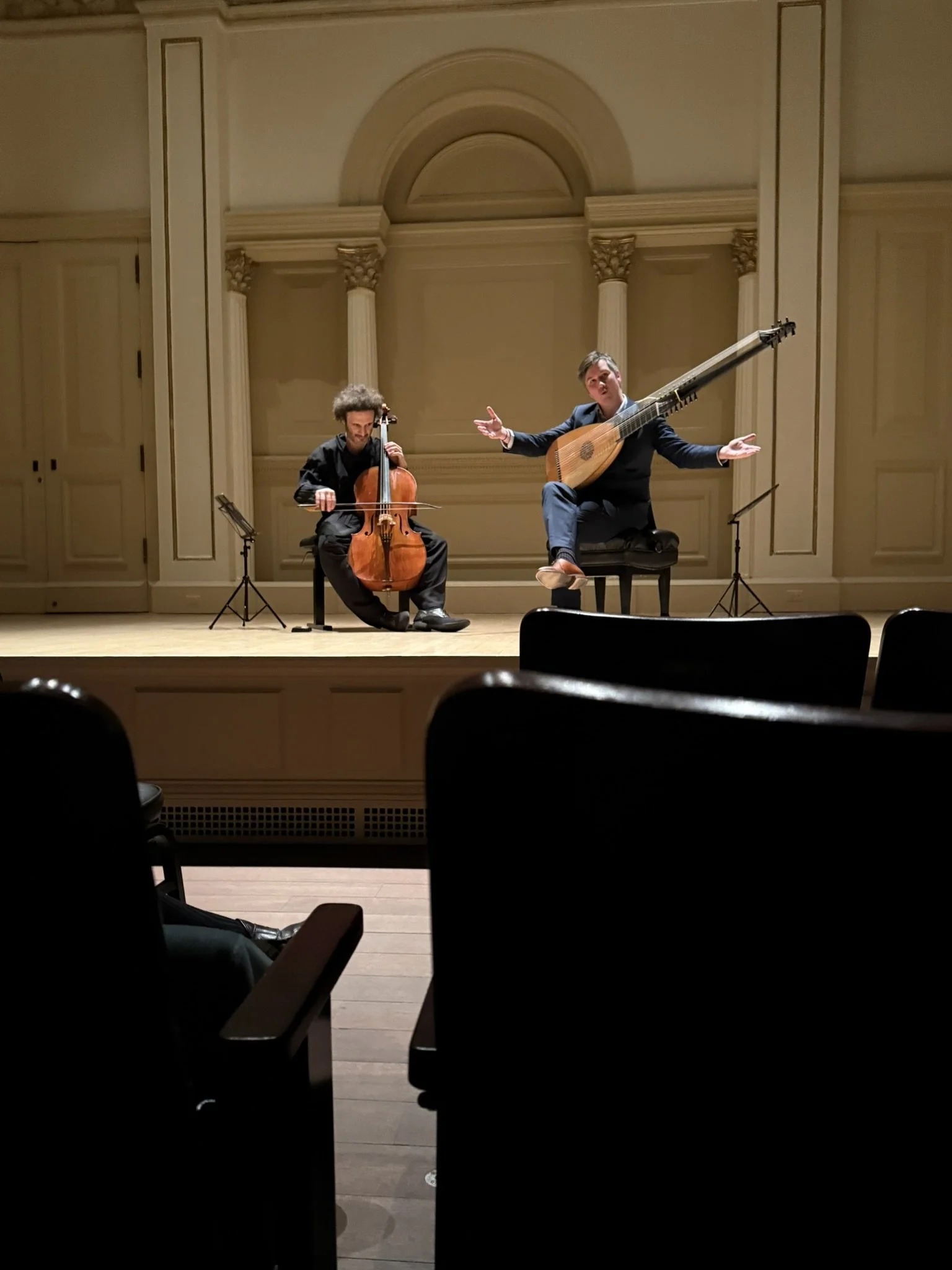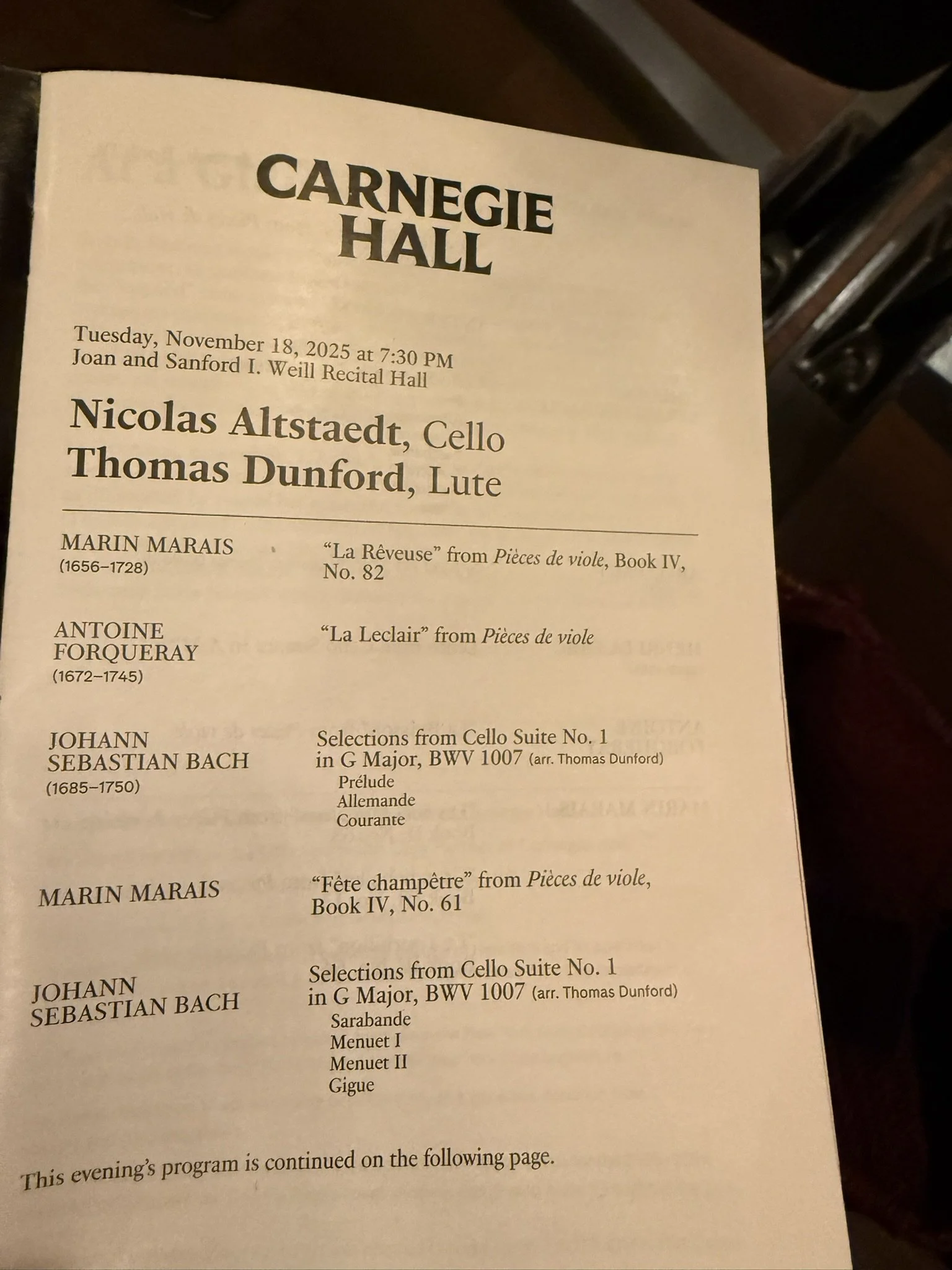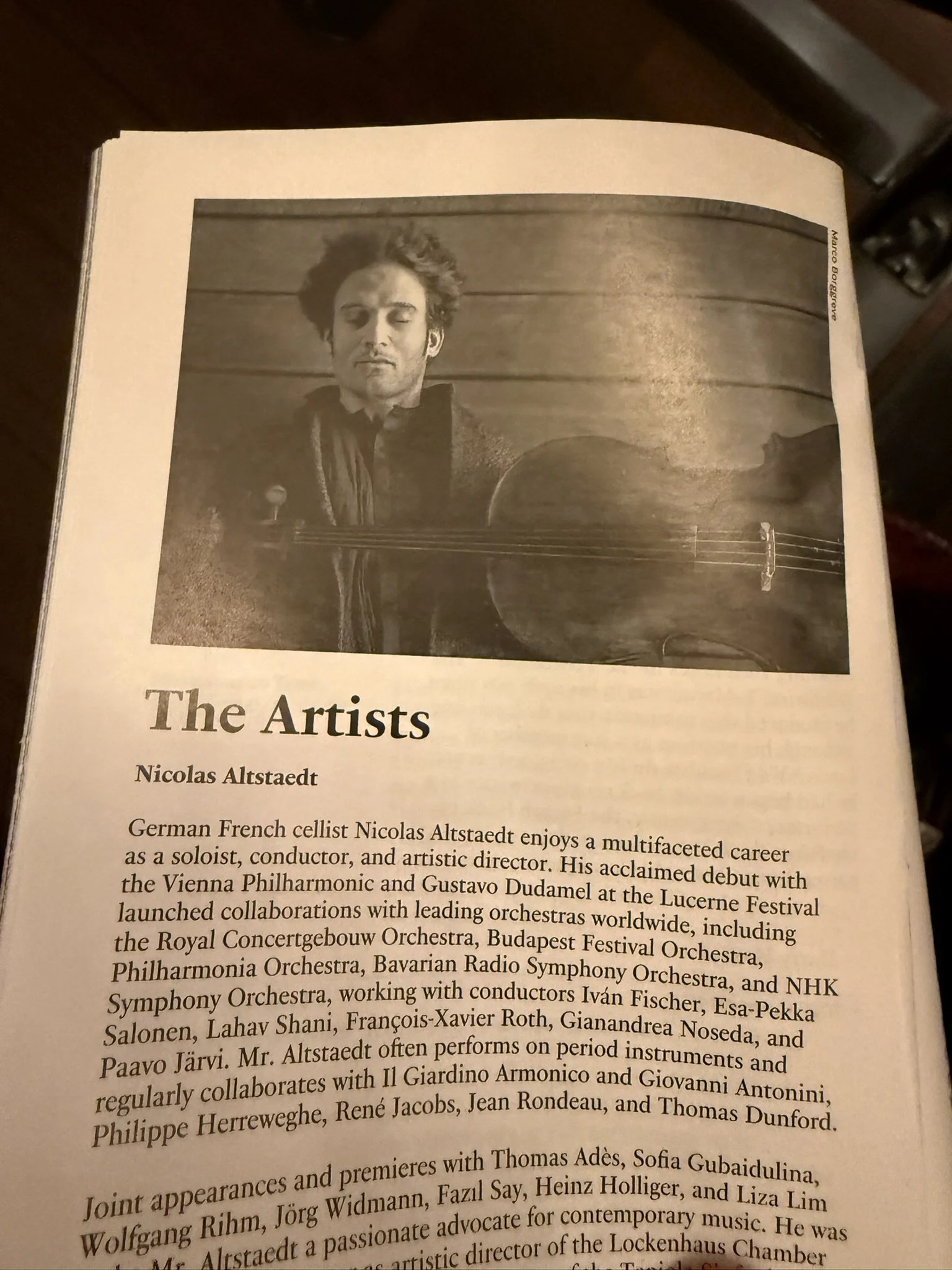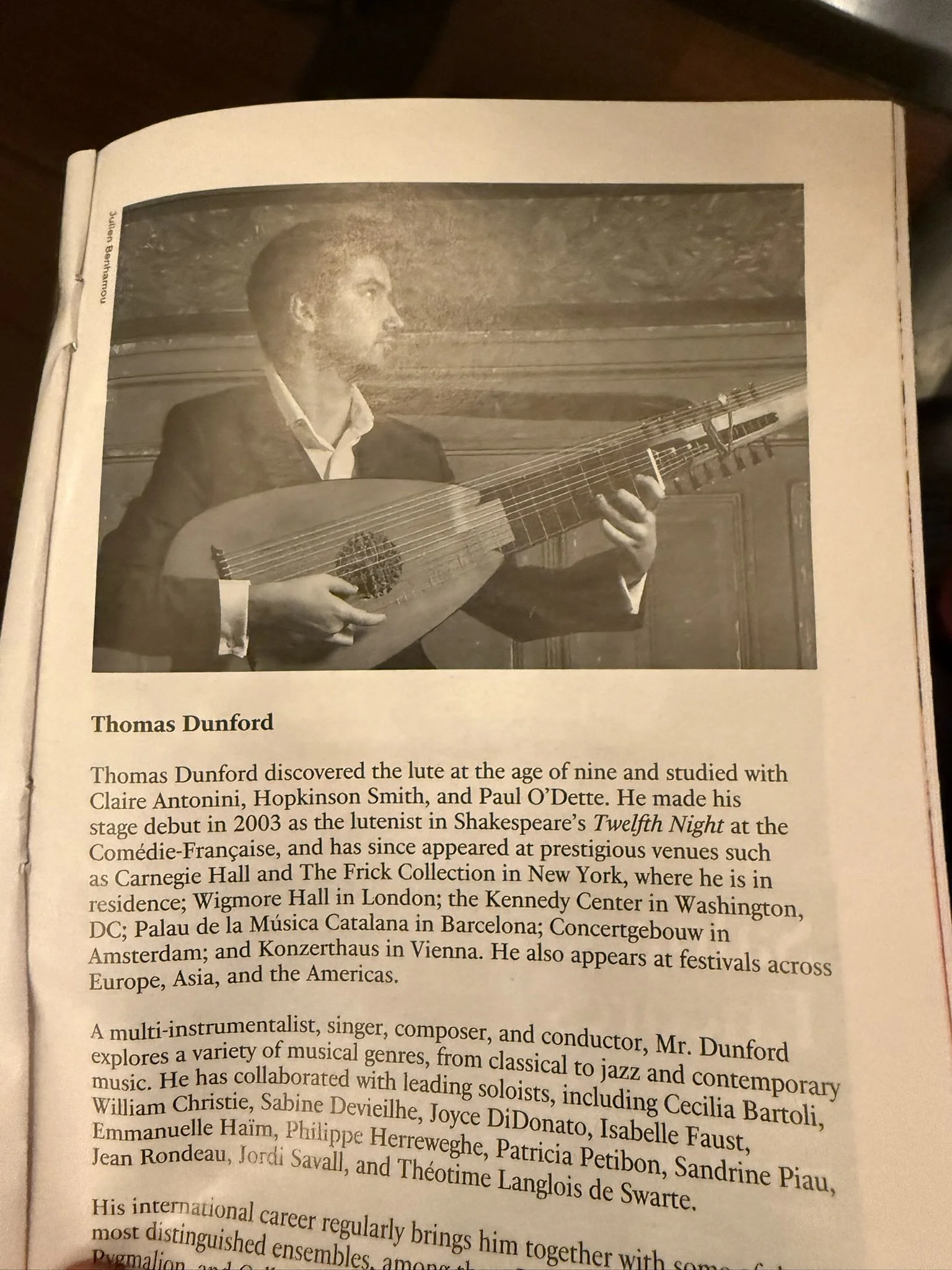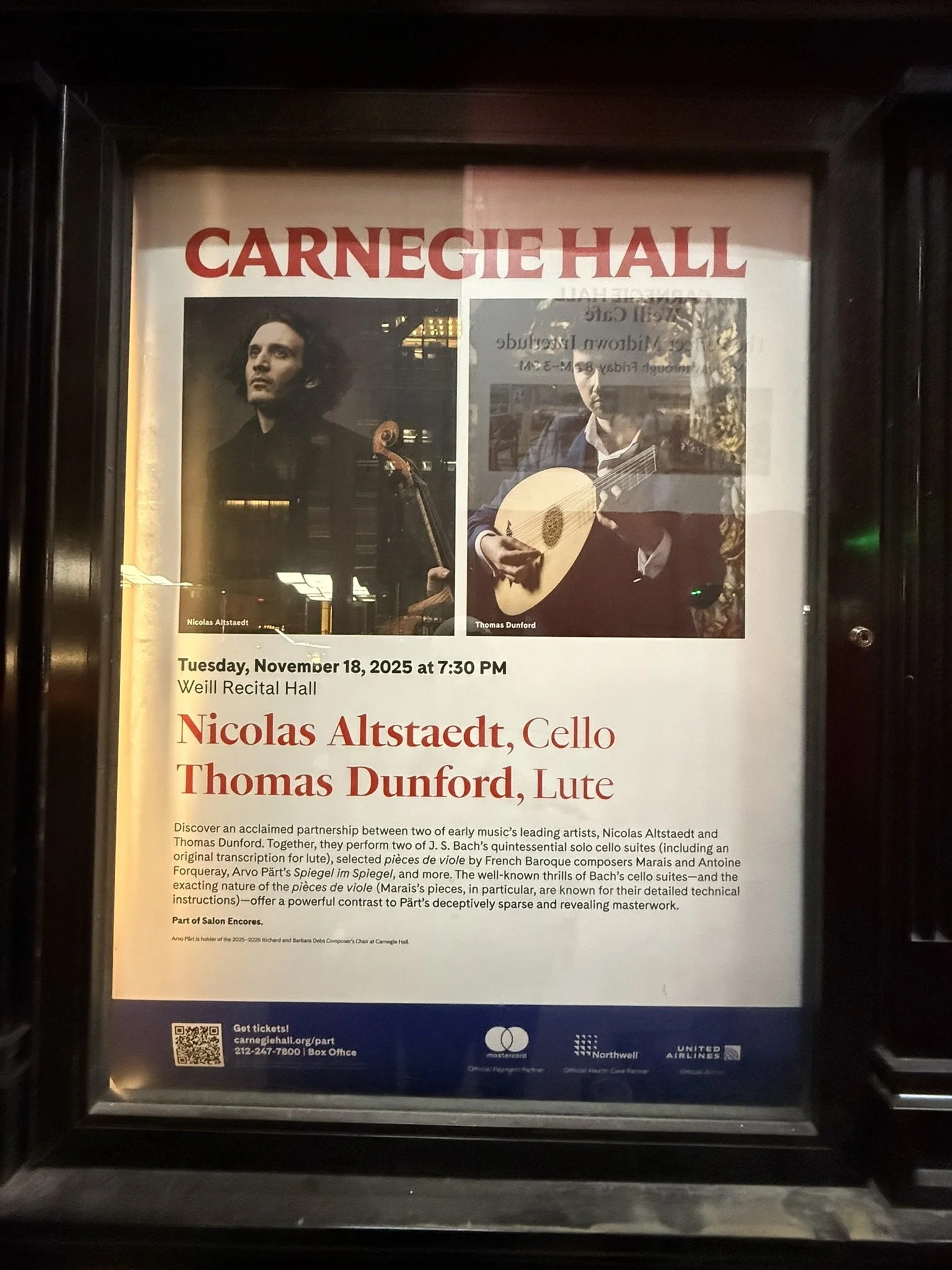The world of Nicolas Altstaedt, Cello and Thomas Dunford, Lute's "viol x cello x lute x Bach x modern." That means all contemporaries, an intimate and stimulating dialogue between the two and the audience. The Bourbon sophistication and Bach. It continues with Pärt and then Marais.
Around 7pm, they were setting up their chairs, probably without even making noie? The program starts with Marais reverie.
Dunford's tremolo stirs deep within, quietly drawing us in. The chords light up like candles, illuminating the contours of a dream, and with each touch of Altstadt's bow, Maret's sigh spreads. The meditations of a nameless dreamer. The world of the viol, which was thought to be lost, is beginning to be recreated here at Carnegie Hall.
Altstadt uses a subtle pre-contact with the bow just before striking the note, raising the overtones before the string is fully struck, creating spatial tension in the foreground of the sound. That extremely thin layer foreshadowed the direction of the phrase, and the following sequence sounded with astonishing clarity. Beyond Altstadt's body, the viol itself began to ring. It paid homage to the Folkle, a work of intensity and nuance. His light, rapid bowing accentuated the subtle noises and overtones that surfaced in the sound, as if wriggling from within the darkness.
Bach's Cello No. 1, arranged by Dunford, began. A dialogue between Dunford and Bach, inspired by the arrangement of the No. 5. by Bach himself. A sculpture of silence and resonance. A deep silence descended, with no one breaking the silence. Then, he quietly returned to the Marais chord. For that moment, the music completely dominated the venue.
Dunford tilted his head toward Altstadt, whose eyes were closed, as if to say, "Your turn." The cello awoke again, and Fête champêtre, a pastoral dance, unfolded. The music continued unabated, with Dunford playing from the Sarabande to the Jig from Bach's Cello Suite No. 1. Once again, Marais's humorous and wild couplets unfolded in a free-flowing session with the cello. From serenity to improvisation, from Bach to Marais. The music stand was removed, and the two enjoyed a free and engaging dialogue.
After the intermission, Altstaedt dedicated Bach's Cello Sonata No. 5. His bow captured the overlapping and shifting notes of Bach's brushstrokes, creating a sympathetic resonance within the instrument. In Pärt's "Spiegel im Spiegel" that followed, time was leveled, and both the audience and the performers synchronized their breathing. The infinite lines of the cello and the transparent pointillism of the lute beautifully intertwined, Pärt's consciousness remaining undisturbed as he quietly filled the space. It was a moment when the god of the instrument resided.
Duparc's Lento followed, quietly enveloping the space with lyricism. Next came "La Buisson," a piece reminiscent of a thicket by Forqueray, branches swaying in the breeze. Then came "Voice Humão," a melody that spoke to the heart. Then came "Grand Ballet," which adorned the stage with splendor. Finally, "Le Tourbillon," with its free and lively music, spoke to each and every member of the audience. In the second half, these two instruments seemed to shine, resonating with each other. For the encore, everyone sang a fun song, then the party was nicely done.\
Nicolas Altstaedt, Cello
Thomas Dunford, Lute
MARAIS "La Rêveuse" from Pièces de viole, Book IV, No. 82
A. FORQUERAY "La Leclair" from Pièces de viole
J. S. BACH Cello Suite No. 1 in G Major (arr. Thomas Dunford)
MARAIS "Le Badinage" from Pièces de viole, Book IV, No. 87
MARAIS "Couplets de folies" from Pièces de viole, Book II, No. 20
J. S. BACH Cello Suite No. 5 in C Minor
ARVO PÄRT Spiegel im Spiegel (transcr. Thomas Dunford)
DUPARC Lento from Cello Sonata in A Minor
MARAIS "Les voix humaines" from Pièces de viole, Book II, No. 63
MARAIS "Grande ballet" from Pièces de viole, Book III, No. 13
MARAIS "Le Tourbillon" from Pièces de viole, Book IV, No. 64
アルトシュテットとダンフォードのヴィオール音楽 × チェロ × リュート × バッハ × 現代”という世界が一続きの物語。親密で、刺激に満ちた2人と聴衆の対話。ブルボン王朝の洗練とバッハ。そして、ペルト、またマレへと続く。
7時ごろ、モニターで彼らは椅子をセットしていた。おそらく音も出していなかった。演奏はマレの夢想から始まる。
薄暗いワイルリサイタルホール。ダンフォードのトレモロに胸の奥を掻き立てられ静かに引き寄せられる。古い教会の地下に眠る死者の中にいる冷たくて落ち着く響き。和音が夢の輪郭を照らす蝋燭のように灯り、アルトシュテットの弓が触れるたびにマレのため息が広がる。名もなき夢想家の思索。失われたはずのヴィオールの世界が、ここカーネギーで再現され始めた。
アルトシュテットは、発音の直前に弓で微細なプレ・コンタクトを用い、弦を完全に鳴らす前の倍音を立ち上げることで、音の前景に空間の張力を作り出す。その極薄い層がフレーズの方向を予告し、続くシークエンスが驚くほど明晰に聞こえ、アルトシュテットの身体を越えて、ヴィオールそのものが鳴りはじめる。烈しさと陰影を併せ持つフォルクレへのオマージュ。軽くて速いボウイングで音の表面に現れる微細なノイズや倍音を強調し、闇の内側から蠢き出すようだった。
ダンフォードの編曲によるバッハの無伴奏チェロ第1番が始まる。5番の編曲にヒントを得たダンフォードとバッハの対話。沈黙と共鳴の彫刻。誰も沈黙を破らず深い静寂が訪れる。そして、彼は静かにマレの和音に戻った。あの一瞬、音楽が会場を完全に支配していた。
ダンフォードは目を閉じたアルトシュテットに向かって、まるで「おまえの番だ」と言わんばかりに首を傾ける。チェロは再び目を覚まし、Fête champêtre、田園の舞踏を繰り広げる。そのまま音楽は流れ、ダンフォードはバッハのチェロ組曲第1番のサラバンドからジグまで弾き進め、再びマレの冗談と狂気に満ちた連句が、チェロとの自由なセッションとして展開される。静謐から即興へ、バッハからマレへ。譜面台をどけ、二人は自由に対話を楽しんでいた。
休憩の後、アルトシュテットはバッハのチェロソナタ第5番を独奏した。バッハの筆を、音の重なりやずれを弓がはじき出し、楽器が共鳴する。サラバンドがじっくりしたテンポで一番面白かった。続くペルトの《シュピーゲル・イム・シュピーゲル》では、時間が水平化され、聴衆も演奏者も呼吸を揃える。チェロの無限線とリュートの透明な点描が美しく絡み合い、ペルトの意識は乱れず、静かに空間を満たした。楽器の神が宿っている瞬間だった。
そのままデュパルクの Lento が続き、叙情が静かに空間を包む。次にフォルクレの茂み、そよ風に揺れる植物の枝のような「La Buisson」が響き、マレの「人間の声」では旋律が心に語りかけ、「グランド・バレエ」では舞台が華やかに彩られ、「ル・トゥールビヨン」では自由で生き生きした音楽が、聴衆一人ひとりに語りかけた。後半は特に楽器同士が鳴り響きあっているように、この2つの楽器が輝いて見えた。


